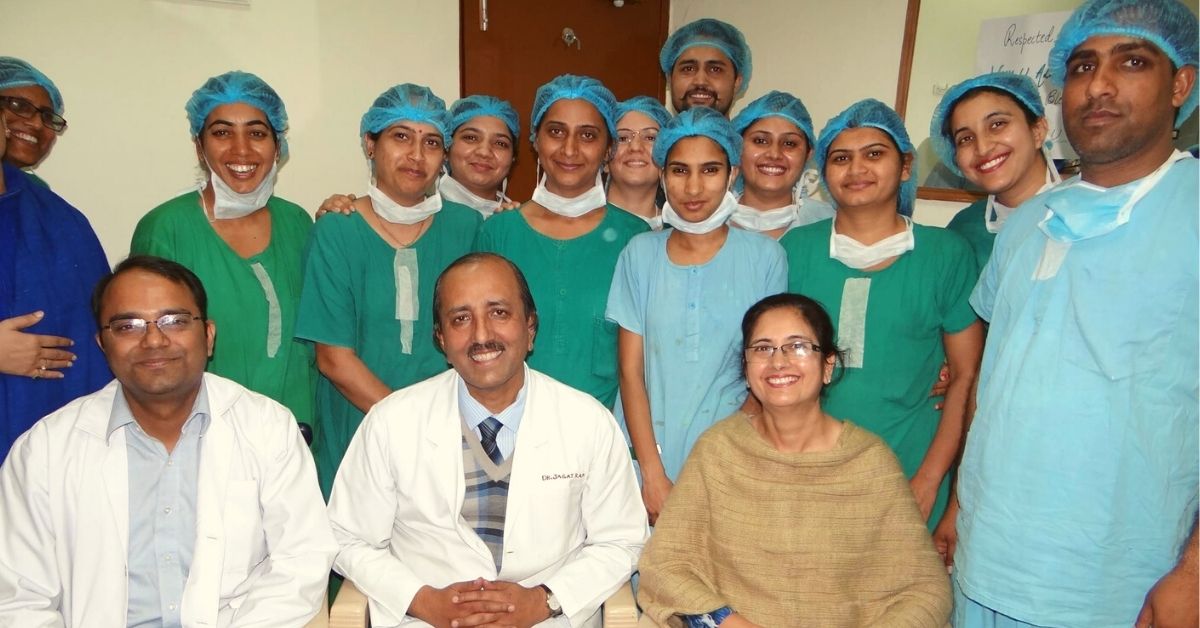Born in a Small Village, This Padma Shri Doctor Was Adjudged World’s ‘Best of The Best’
The director of PGIMER Chandigarh, Dr Jagat Ram grew up in a small village in Himachal Pradesh and went on to win the Padma Shri for his trailblazing work in the world of cataract surgery.

As kids, people are often asked what they want to be when they grow up. For Jagat, as a small boy who spent most of his time working in the fields or buried in books, this question was exceptionally hard.
“I wanted to study and also help my father. We were very poor and I wanted to study hard and help my family. I just did not know the best way to do it as a young boy,” says Jagat who eventually became one of the best doctors in the country.
Now known as Dr Jagat Ram, he is one of India’s top medical professionals with over 35 national and international awards to his name, including the prestigious Padma Shri.
In 2013, he was also conferred with an international award for a new surgical technique in ophthalmology naming him the ‘Best of the Best’ doctor in the world, at the American Society of Cataract and Refractive Surgery Conference.
From a poor farmer family living in a small village of Himachal Pradesh to becoming one of the forerunners of medical science in India, Dr Ram has come a long way, but the road so far has been anything but ordinary.
Learning to dream big

Born in a village called Pabiyana, in Sirmaur district of Himachal Pradesh, Dr Ram had envisioned a very ordinary life for himself, much the other village-folk.
“We were not from a well to do family so dreaming big was not something that came naturally to us. I grew up helping my father in the fields and then working there on my own to fund studies. After a hard day of work, it was my books that made me feel a sense of purpose and gave me the hope to make things better,” says Dr Ram, who as a boy would travel 9 to 10 kilometres to school, every single day.
The rural government school where young Dr Ram studied, was only till Class 9. So in 1971, he moved to Solan, a town that was almost 40 kilometres away from home.
“Traveling that stretch every day was not possible as connectivity was not that great at the time, so I had to stay in a hostel there. Things were difficult but my father would always motivate me saying that hard work is the only way to success. This thought constantly guided me through my time there,” he adds.
But, after completing Class 10, he had to confront the big question – what to do next? A good student with clipped dreams, it was a teacher who eventually guided him in the right direction.
“I scored good marks in the matric exam so I went to a teacher with my report card seeking guidance. Looking at my marks and the potential they advised me to take up medicine. At the time, I did not have a great idea about how I would pursue the field, but with the help of several individuals including my teachers, things somehow fell into place,” says Dr Ram who completed MBBS in 1978 from Indira Gandhi Medical College & Hospital, Shimla.
From a student, faculty to the director

According to Dr Ram, coming to Post Graduate Institute of Medical Education and Research (PGIMER), Chandigarh was a turning point in his life. Having spent 41 years at the institute in various capacities, he believes that the institute helped shape the doctor he is today.
But his entry to a prestigious institute is yet another interesting story – “Instead of going for a government job in Himachal Pradesh, I wanted to study further and hone my skills as a doctor. So I applied to study Ophthalmology at PGIMER in 1979. On the assigned date when the merit list was supposed to be declared, I went to the institute to check. But I was so naïve that instead of reading the list of selected candidates, I ended up scouring the list of rejected candidates.
Disappointed and broken, Dr Ram went to a nearby eucalyptus tree outside the director’s office, and in an effort to calm his senses, slept off. It was sometime later that a professor and a prominent ophthalmologist at the institute, DR MR Dogra woke him up in haste.
“Apparently, all this time when I was sleeping, people were actually calling my name inside,” he laughs.
From this to becoming a prominent faculty in 1994, head of the department in 2015 and finally the director of PGIMER in March 2017, Dr Ram has accomplished several exemplary feats in his 41-year-long journey with the institute. But it is the work on a ground-level that he feels that truly gives him happiness.
“Growing up in a village, I would often see several cases of cataract blindness. Losing one’s eyesight after a certain age was quite common and extremely challenging, especially as many of their livelihood depended on labour. I wanted to make a difference there and that was one of the major reasons why I took up ophthalmology. Later in my initial years as a doctor, I participated in and conducted several free eye-camps in remote villages of Himachal Pradesh, Punjab and Haryana,” adds the 63-year-old doctor who is internationally acclaimed for his contributions in the area of cataract and refractive surgery.
In 1993, he visited the USA for a World Health Organisation (WHO) fellowship in advanced phacoemulsification and was also awarded a second fellowship in 1998 in Paediatric Cataract surgery. Then, from 2003 to 2005, Dr Ram was also deputed by the Ministry of External Affairs at the Republic of Seychelles, as a phacoemulsification practitioner. Phacoemulsification essentially is a modern cataract surgery technique which was an uncommon skill mastered by a very few doctors, including Dr Ram. According to him, it was these experiences that served an eye-opener for him and helped him carve his career in a bigger and better direction.
Becoming the Best

In 1994, Dr Jagat Ram introduced the technique of phacoemulsification while working at PGIMER as a faculty member. This technique replaced the older method of extracapsular cataract extraction (ECCE), which according to several reports, provides better visual acuity with lower risks.
Almost a year later, he began to use the method to operate patients suffering from cataract blindness and was able to successfully restore their vision. In the last 4 decades, Dr Ram has successfully conducted over 90,000 cataract surgeries in adult patients and over 10,000 surgical procedures on children. He has also offered free eye-care services in over 130 relief and screening camps in rural areas.
Talking about Dr Ram, one of his patients, Captain Narinder Singh IAS, who underwent a cataract surgery in 2013 says, “A good doctor is not just a professional who is competent but is also very compassionate. Dr Ram has both the qualities and more. I remember how even in an overwhelming crowd of patients, he would manage to keep his calm smile, while dealing with each patient with care and compassion. I never saw him flinch under pressure, rather that got the best out of him. Be it during treatment or surgery he makes sure each and every patient feels safe and without fear. That is truly a remarkable quality to find in a doctor.”
Owing to his exemplary efforts to develop the country’s eye-care facility, both in terms of ground-level work as well as research, he was awarded the prestigious ‘Best of the Best Award’. He had received the award in the category of New Surgical Technique at the American Society of Cataract and Refractive Surgery Conference held at San Francisco.
A rare feat, his technique had won over the research and innovation of more than 10,000 ophthalmologists from more than 120 countries.
Out of the total of 180 video presentations of innovation, Dr Ram’s work on implantation of customized intraocular lenses (which are artificially implanted to treat cataract or myopia) in a child with double crystalline lens was declared as ‘Best of the Best’.
It was quite a rare case, where two congenital crystalline lenses or duplicate lenses are formed on a single eye. The video demonstrated the technique where Dr Ram’s special intraocular lens was successfully implanted for the first time, providing a positive visual outcome. It was touted to be a breakthrough of sorts in the area of treatment of cataract among children.
His unparalleled contribution in the field of medicine won him the prestigious Padma Shri award in 2019, as well.
“As a medical practitioner and teacher, all I wish for is to do my best in passing the bulk of knowledge to a competent and motivated generation that uses the best of technology to serve people in the true sense. I am doing my bit to live that dream and hope that someone too would follow suit,” he concludes.
(Edited by Vinayak Hegde)

Similar Story

Would Your Parents Support You Taking Therapy? This Mental Wellbeing Survey Reveals an Unseen Change
An ITC Fiama survey on mental health shows 80% of Indians trust their parents to back them in seeking therapy, signalling a change in how its perceived by Gen Z, millennials, and their parents.
Read more >
If you found our stories insightful, informative, or even just enjoyable, we invite you to consider making a voluntary payment to support the work we do at The Better India. Your contribution helps us continue producing quality content that educates, inspires, and drives positive change.
Choose one of the payment options below for your contribution-
By paying for the stories you value, you directly contribute to sustaining our efforts focused on making a difference in the world. Together, let's ensure that impactful stories continue to be told and shared, enriching lives and communities alike.
Thank you for your support. Here are some frequently asked questions you might find helpful to know why you are contributing?


This story made me
-
97
-
121
-
89
-
167












